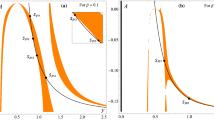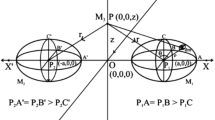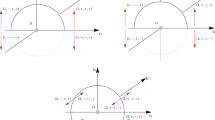Abstract
In this paper, we have drawn the periodic orbits in the restricted four-body problem. The fourth body of infinitesimal mass moves under the Newtonian gravitational law due to three mass points (known as primaries) in the collinear Euler’s configuration. We have studied the dynamics of the fourth body in the spatial collinear restricted four-body problem (SCR4BP) with non-spherical primaries. We have determined the periodic orbits by using the Fourier series method only around collinear libration points in SCR4BP with non-spherical primaries. The effects of the orbital parameter \(\varepsilon \) (\(0<\varepsilon <1\)), which controls the size of the orbit, on the periodic orbits and their period are investigated. In order to study the effect of this parameter, we have retained the terms up to third order with respect to the orbital dimensions. We have also drawn the variational graphs to determine the variation in the time period T of the periodic orbits. Moreover, we have unveiled that how oblateness and mass parameters influence the shape, size, and period of the periodic orbits.









Similar content being viewed by others
Data availability
All the incorporated data that support the findings of this study are available in the article and in its supplementary material files.
References
Alvarez-Ramírez, M., Barrabés, E., Medina, M., Ollé, M.: Ejection–collision orbits in the symmetric collinear four-body problem. Commun. Nonlinear Sci. Numer. Simul. 71, 82–100 (2019). https://doi.org/10.1016/j.cnsns.2018.10.026
Arribas, M., Abad, A., Elipe, A., Palacios, M.: Equilibria of the symmetric collinear restricted four-body problem with radiation pressure. Astrophys. Space Sci. 361, 84 (2016). https://doi.org/10.1007/s10509-016-2671-x
Baltagiannis, A.N., Papadakis, K.E.: Equilibrium points and their stability in the restricted four-body problem. Int. J. Bifurc. Chaos 21, 2179–2193 (2011). https://doi.org/10.1142/S0218127411029707
Baltagiannis, A.N., Papadakis, K.E.: Families of periodic orbits in the restricted four-body problem. Astrophys. Space Sci. 336, 357–367 (2011). https://doi.org/10.1007/s10509-011-0778-7
Baltagiannis, A.N., Papadakis, K.E.: Periodic solutions in the Sun–Jupiter–Trojan Asteroid–Spacecraft system. Planet. Space Sci. 75, 148–157 (2013). https://doi.org/10.1016/j.pss.2012.11.006
Bhatnagar, K.B., Chawla, J.M.: The effect of oblateness of the bigger primary on collinear libration points in the restricted problem of three bodies. Celest. Mech. 16, 129–136 (1977)
Brown, E.W.: On the oscillating orbits about the triangular equilibrium points in the problem of three bodies. Mon. Not. R. Astron. Soc. 71, 492–502 (1911)
Burgos-García, J., Delgado, J.: Periodic orbits in the restricted four-body problem with two equal masses. Astrophys. Space Sci. 345, 247–263 (2013). https://doi.org/10.1007/s10509-012-1118-2
Burgos-García, J.: Families of periodic orbits in the planar Hill’s four-body problem. Astrophys. Space Sci. 361, 353 (2016). https://doi.org/10.1007/s10509-016-2943-5
Burgos-García, J., Lessard, Jean-P., Mireles James, J.D.: Spatial periodic orbits in the equilateral circular restricted four-body problem: computer-assisted proofs of existence. Celest. Mech. Dyn. Astron. 131, 2 (2019). https://doi.org/10.1007/s10569-018-9879-8
Elipe, A.: On the restricted three-body problem with generalized forces. Astrophys. Space Sci. 188, 257–269 (1992)
Elipe, A., Ferrer, S.: On the equilibrium solutions in the circular planar restricted three rigid bodies problem. Celest. Mech. 37(1), 59–70 (1985). https://doi.org/10.1007/BF01230341
Elipe, A., Lara, M.: Periodic orbits in the restricted three body problem with radiation pressure. Celest. Mech. Dyn. Astron. 68, 1–11 (1997). https://doi.org/10.1023/A:1008233828923
Elipe, A., Abad, A., Arribas, M., Ferreira, A.F.S., de Moraes, R.V.: Symmetric periodic orbits in the dipole-segment problem for two equal masses. Astron. J. 161, 274 (2021). https://doi.org/10.3847/1538-3881/abf353
Farquhar, R.W.: The control and use of libration-point satellites. Ph.D. thesis, Stanford University, Stanford, California (1968)
Giacaglia, G.E.O.: Regularization of the restricted problem of four bodies. Astron. J. 69, 165 (1967). https://doi.org/10.1086/110291
Hénon, M.: Families of periodic orbits in the three-body problem. Celest. Mech. 10, 375–388 (1974)
Kalvouridis, T., Arribas, M., Elipe, A.: Parametric evolution of periodic orbits in the restricted four-body problem with radiation pressure. Planet. Space Sci. 55(4), 475–493 (2007). https://doi.org/10.1016/j.pss.2006.07.005
Llibre, J., Saeed, T., Zotos, E.E.: Periodic orbits and equilibria for a seventh-order generalized Hénon–Heiles Hamiltonian system. J. Geom. Phys. 167, 104290 (2021). https://doi.org/10.1016/j.geomphys.2021.104290
Llibre, J., Paşca, D., Valls, C.: The circular restricted four-body problem with three equal primaries in the collinear central configuration of the three-body problem. Celest. Mech. Dyn. Astron. 133, 53 (2021). https://doi.org/10.1007/s10569-021-10052-6
Majorana, A.: On a four-body problem. Celest. Mech. 25, 267–270 (1981). https://doi.org/10.1007/BF01228963
Michalodimitrakis, M.: The circular restricted four-body problem. Astrophys. Space Sci. 75, 289–305 (1981). https://doi.org/10.1007/BF00648643
Mittal, A., Ahmad, I., Bhatnagar, K.B.: Periodic orbits in the photogravitational restricted problem with the smaller primary an oblate body. Astrophys. Space Sci. 323, 65–73 (2009). https://doi.org/10.1007/s10509-009-0038-2
Palacios, M., Arribas, M., Abad, A., Elipe, A.: Symmetric periodic orbits in the Moulton–Copenhagen problem. Celest. Mech. Dyn. Astron. 131, 16 (2019). https://doi.org/10.1007/s10569-019-9893-5
Papadakis, K.E.: Families of periodic orbits in the photogravitational three-body problem. Astrophys. Space Sci. 245, 1–13 (1996). https://doi.org/10.1007/BF00637799
Papadakis, K.E.: Homoclinic and heteroclinic orbits in the photogravitational restricted three-body problem. Astrophys. Space Sci. 302, 67–82 (2006). https://doi.org/10.1007/s10509-005-9007-6
Papadakis, K.E.: Asymptotic orbits in the restricted four-body problem. Planet. Space Sci. 55, 1368–1379 (2007). https://doi.org/10.1016/j.pss.2007.02.005
Papadakis, K.E., Ragos, O., Litzerinos, C.: Asymmetric periodic orbits in the photogravitational Copenhagen problem. J. Comput. Appl. Math. 227(1), 102–114 (2009)
Papadakis, K.E.: Families of three-dimensional periodic solutions in the circular restricted four-body problem. Astrophys. Space Sci. 361, 129 (2016). https://doi.org/10.1007/s10509-016-2713-4
Papadouris, J.P., Papadakis, K.E.: Periodic solutions in the photogravitational restricted four-body problem. Mon. Not. R. Astron. Soc. 442, 1628–1639 (2014). https://doi.org/10.1093/mnras/stu981
Pedersen, P.: On the periodic orbits in the neighbourhood of the triangular equilibrium points in the restricted problem of three bodies. Mon. Not. R. Astron. Soc. 94, 167–184 (1933). https://doi.org/10.1093/mnras/94.2.167
Pedersen, P.: Fourier series for the periodic orbits around the triangular libration points. Mon. Not. R. Astron. Soc. 95, 482–495 (1935)
Qian, Y.J., Liu, Y., Zhang, W., Yang, X.D., Yao, M.H.: Stationkeeping strategy for quasi-periodic orbit around Earth–Moon \(L_2\) point. J. Aerosp. Eng. 230(4), 760–775 (2016). https://doi.org/10.1177/0954410015597257
Qian, Y.J., Zhang, W., Yang, X.D., Yao, M.H.: Energy analysis and trajectory design for low-energy escaping orbit in Earth–Moon system. Nonlinear Dyn. 85(1), 463–478 (2016). https://doi.org/10.1007/s11071-016-2699-z
Qian, Y.J., Yang, X.D., Zhang, W., Zhai, G.Q.: Periodic motion analysis around the libration points by polynomial expansion method in planar circular restricted three-body problem. Nonlinear Dyn. 91, 39–54 (2018). https://doi.org/10.1007/s11071-017-3818-1
Rabe, E.: Determination and survey of periodic trojan orbits in the restricted problem of three bodies. Astron. J. 66, 500 (1961). https://doi.org/10.1086/108451
Rabe, E., Schanzle, A.: Periodic librations about the triangular solutions of the restricted Earth–Moon problem and their orbital stabilities. Astron. J. 67, 10 (1962). https://doi.org/10.1086/108802
Roy, A.E.: Orbital Motion. Adam Hilger Ltd., Bristol (1982)
Schuerman, D.W.: The restricted three-body problem including radiation pressure. Astrophys. J. 238, 337–342 (1980)
Simmons, J.F.L., McDonald, A.J.C., Brown, J.C.: The restricted 3-body problem with radiation pressure. Celest. Mech. 35, 145–187 (1985)
Strömgren, E.: Connaissance actuelle des orbites dans le problme des trois. corps. Bull. Astron 9, 87–130 (1933)
Suraj, M.S., Aggarwal, R., Mittal, A., Meena, O.P., Asique, M.C.: On the spatial collinear restricted four-body problem with non-spherical primaries. Chaos Solitons Fractals 133, 109609 (2020). https://doi.org/10.1016/j.chaos.2020.109609
Verrier, P.E., McInnes, C.R.: Periodic orbits for three and four co-orbital bodies. Mon. Not. R. Astron. Soc. 442, 3179–3191 (2014). https://doi.org/10.1093/mnras/stu1056
Zhou, Y., Zhang, W.: Analysis on nonlinear dynamics of two first-order resonances in a three-body system. Eur. Phys. J. Spec. Top. 231, 2289–2306 (2022). https://doi.org/10.1140/epjs/s11734-022-00428-6
Zotos, E.E.: Classifying orbits in the restricted three-body problem. Nonlinear Dyn. 82, 1233 (2015). https://doi.org/10.1007/s11071-015-2229-4
Zotos, E.E.: Revealing the escape mechanism of three-dimensional orbits in a tidally limited star cluster. Mon. Not. R. Astron. Soc. 446, 770–792 (2015). https://doi.org/10.1093/mnras/stu2129
Zotos, E.E.: Comparing the escape dynamics in tidally limited star cluster models. Mon. Not. R. Astron. Soc. 452(1), 193–209 (2015). https://doi.org/10.1093/mnras/stv1307
Zotos, E.E.: Crash test for the Copenhagen problem with oblateness. Celest. Mech. Dyn. Astron. 122, 75–99 (2015). https://doi.org/10.1007/s10569-015-9611-x
Zotos, E.E.: How does the oblateness coefficient influence the nature of orbits in the restricted three-body problem? Astrophys. Space Sci. 358, 33 (2015). https://doi.org/10.1007/s10509-015-2435-z
Zotos, E.E.: Orbital dynamics in the planar Saturn-Titan system. Astrophys. Space Sci. 358(1), 1–12 (2015). https://doi.org/10.1007/s10509-015-2403-7
Zotos, E.E., Dubeibe, F.L., González, G.A.: Orbit classification in an equal-mass non-spinning binary black hole pseudo-Newtonian system. Mon. Not. R. Astron. Soc. 477(4), 5388–5405 (2018). https://doi.org/10.1093/mnras/sty946
Zotos, E.E., Jung, C.: Orbital and escape dynamics in barred galaxies-III. The 3D system: correlations between the basins of escape and the NHIMs. Mon. Not. R. Astron. Soc. 473(1), 806–825 (2018). https://doi.org/10.1093/mnras/stx2398
Zotos, E.E., Nagler, J.: On the classification of orbits in the three-dimensional Copenhagen problem with oblate primaries. Int. J. Non-Linear Mech. 108, 55–71 (2019). https://doi.org/10.1016/j.ijnonlinmec.2018.10.009
Zotos, E.E., Jung, C., Papadakis, K.E.: Families of periodic orbits in a double-barred galaxy model. Commun. Nonlinear Sci. Numer. Simul. 89, 105283 (2020). https://doi.org/10.1016/j.cnsns.2020.105283
Zotos, E.E., Erdi, B., Saeed, T., Alhodaly, M.S.: Orbit classification in exoplanetary systems. Astron. Astrophys. 634, A60 (2020). https://doi.org/10.1051/0004-6361/201937224
Zotos, E.E., Erdi, B., Saeed, T.: Classification of orbits in three-dimensional exoplanetary systems. Astron. Astrophys. 645, A128 (2021). https://doi.org/10.1051/0004-6361/202039690
Zotos, E.E., Papadakis, K.E., Wageh, T.: Mapping exomoon trajectories around Earth-like exoplanets. Mon. Not. R. Astron. Soc. 502, 5292–5301 (2021). https://doi.org/10.1093/mnras/stab421
Acknowledgements
Authors are thankful to the two anonymous reviewers, whose comments and suggestions are very useful in improving the manuscript.
Funding
The authors state that they have not received any funding.
Author information
Authors and Affiliations
Corresponding author
Ethics declarations
Conflict of interest
The authors state that they have not received any research grants and have no known competing personal relationships that could have appeared to influence the work reported in this paper.
Additional information
Publisher's Note
Springer Nature remains neutral with regard to jurisdictional claims in published maps and institutional affiliations.
Appendices
A The values of various coefficients in Eq. 11a
B The values of various coefficients in Eq. 11b
C The values of various coefficients in the expansion of potential function U
D The values of various coefficients in the coefficient scheme Table 3
E The values of various coefficients in the second-order terms \(a_0, b_0, a_{\pm 2} \, \text {and}\, b_{\pm 2} \)
F The values of various coefficients in the third-order terms \(a_{\pm 3}\) and \(b_{\pm 3}\)
G The values of various coefficients in \(q_1, q_2,\) \(q_3\) and \(q_4\)
H The values of various coefficients in the expression of E
I The values of various coefficients in the first-order terms \(a_{-1} \, \text {and}\, b_{-1}\)
Rights and permissions
Springer Nature or its licensor (e.g. a society or other partner) holds exclusive rights to this article under a publishing agreement with the author(s) or other rightsholder(s); author self-archiving of the accepted manuscript version of this article is solely governed by the terms of such publishing agreement and applicable law.
About this article
Cite this article
Suraj, M.S., Meena, O.P., Aggarwal, R. et al. On the periodic orbits around the collinear libration points in the SCR4BP with non-spherical primaries. Nonlinear Dyn 111, 5547–5577 (2023). https://doi.org/10.1007/s11071-022-08131-w
Received:
Accepted:
Published:
Issue Date:
DOI: https://doi.org/10.1007/s11071-022-08131-w




